Flag of Russia
 | |
| Name |
Триколор Trikolor Tricolor |
|---|---|
| Use | Civil and state flag, civil and state ensign |
| Proportion | 2:3 |
| Adopted |
11 May (29 April O.S.) 1696 (Originally de jure) 1700 (de facto for vessels) 1883 (de facto for land use) 12 August 1991 (de facto as flag of post-soviet Russia) 11 December 1993 (flag of RF) |
| Design | A horizontal tricolour of white, blue and red |
|
Variant flag of Russian Federation | |
| Use | Presidential Standard |
| Proportion | 1:1 |
| Adopted | 1993 |
| Design | A tricolor defaced with the double-headed eagle |
|
Variant flag of Russian Federation | |
| Proportion | 2:3 |
| Design | Same as the colors above, but specified by the Government's website. |
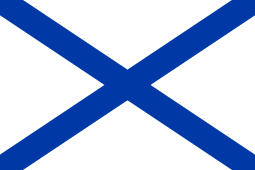 | |
| Name |
Андреевский флаг Andreyevsky flag St. Andrew Flag |
| Use | Naval ensign |
| Adopted | 1992[1] (originally adopted in 1720[2]) |
| Design | White with a blue saltire. |
|
Flag of the Soviet Union (1980-1991) | |
| Name | The Red Banner[3] |
| Use | Historical, occasionally in use including the Communist Party of the Russian Federation, and during the Victory Day parade. |
| Proportion | 1:2 |
| Adopted |
12 November 1923 (original version) 15 August 1980 (last version used) Relinquished on 26 December 1991 as national flag. |
| Design | A plain red flag with a golden hammer and sickle and a gold-bordered red star in its upper canton. |
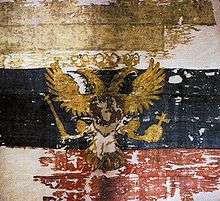
The flag of Russia is a tricolor flag consisting of three equal horizontal fields: white on the top, blue in the middle and red on the bottom. The flag was first used as an ensign for Russian merchant ships and became official as the flag of the Tsardom of Russia in 1696. It remained in use until the establishment of the Russian Socialist Federative Soviet Republic in 1917. It was re-introduced as the flag of the Russian Federation in 1991.
Origin
Two accounts of the flag's origin connect it to the tricolor used by the Dutch Republic (the flag of the Netherlands).[4][5]
The earliest mention of the flag occurs during the reign of Alexis I, in 1668, and is related to the construction of the first Russian naval ship, the frigate Oryol. According to one source, the ship's Dutch lead engineer Butler faced the need for the flag, and issued a request to the Boyar Duma, to "...ask His Royal Majesty as to which (as is the custom among other nations) flag shall be raised on the ship." The official response merely indicated that, as such issue is as yet unprecedented, even though the land forces do use (apparently different) flags, the tsar ordered that his (Butler's) opinion be sought about the matter, asking specifically as to the custom existing in his country.[6]
A different account traces the origins of the Russian flag to tsar Peter the Great's visits to Arkhangelsk in 1693 and 1694. Peter was keenly interested in shipbuilding in the European style, different from the barges ordinarily used in Russia at the time. In 1693, Peter had ordered a Dutch-built frigate from Amsterdam. In 1694 when it arrived, the Dutch red-white-and-blue banner flew from its stern.[7] Peter decided to model Russia's naval flag after this banner by changing the sequence of colors.
The Dutch flag book of 1695 by Carel Allard, printed only a year after Peter's trip to Western Europe, describes the tricolor with a double-headed eagle bearing a shield on its breast, and wearing a golden crown over both of its heads.
History
The 1695 flag book by Carel Allard describes three flags used by the tsar of Muscovy: The tricolour with the double-headed eagle bearing a shield on its breast and wearing a golden crown over both of its heads, the tricolour with a blue saltire over it, and a third showing red and white quartering with a blue cross over all.[8]
The Russian tricolour flag was adopted as a merchant flag at rivers in 1705. The choice of colors is significant in that they represent in order of priority, white for God, Blue for king and Red for people and/or country These colors of the flag of Russia inspired the choice of the "Pan-Slavic colours" by the Prague Slavic Congress, 1848. Two other Slavic countries, Slovakia and Slovenia, have flags similar to the Russian one, but with added coats-of-arms for differentiation.
On 7 May 1883, the Russian flag was authorized to be used on land, and it became an official National flag before the coronation of Tsar Nicholas II in 1896.
The flag continued to be used by the Russian Provisional Government after the Tsar was toppled in the February Revolution and was not replaced until the October Revolution which established the Russian Socialist Federative Soviet Republic. From that time period, a 1:2 red flag featuring the abbreviated name "RSFSR" ("РСФСР") was used, until replaced in 1954 with the universal design of the Soviet flag with a blue stripe along the mast. During the Second World War the white-blue-red tricolor has been used by the collaborationist troops of Andrey Vlasov, who was allied with Nazi Germany against the Soviet Union.[9][10] It was not until the dissolution of the Soviet Union in 1991 that the tricolor was brought back as the official flag of the new Russian Federation. The modern era flag underwent a proportion change in 1993 and has been official since 2000.
Color specifications
| Scheme | White | Blue | Red |
|---|---|---|---|
| Pantone | White | 286C | 485C |
| RGB | 255-255-255 (#ffffff) | 0-57-166 (#0039a6)[11] | 213-43-30 (#d52b1e)[12] |
| HTML | #FFFFFF | #0039A6 | #D52B1E |
Variant versions
A variant of the flag was authorized for private use by Tsar Nicholas II before World War I, adding the large state eagle on a yellow field (imperial standard) in a canton in the top left-hand corner. Or was never made the official state flag.
When the Bolsheviks took power in 1917, the tricolor design was discarded, and a definitive new flag of the SFSR (one of the constituent republics of the Soviet Union) was introduced in 1954 (see flag of Russian SFSR), and this remained the republic's flag until the collapse of the Soviet Union in 1991. All of the Soviet Republics' flags were created by introducing a small but noticeable change to the flag of the Soviet Union. For Russia, the change was an introduction of the left-hand blue band. The previous Soviet design was different, a plain red flag with different variants of the "RSFSR" abbreviation in the canton.
The tricolor was used by the antcommunist forces during the Civil War called the White movement. It was continued to be used by White émigrés in various countries as the Russian flag. The tricolor was associated both in Soviet Russia as well as the Russian White emigre communities as symbolizing a traditional tsarist Orthodox Russia. It, as well as the naval ensign of the Imperial Russian Navy was used by anticommunist Russian troops under German command during the Second World War. Both flags can be seen inside a few Orthodox churches in the West established by the Russian communities. In the Soviet Union, this flag was used in films set in the prerevolutionary period and was seen as an historical flag, especially after the 1940s.
It, rather than the black-yellow-white color combination, was readopted by Russia on 22 August 1991. That date is celebrated yearly as the national flag day.
The President of Russia uses a Presidential Standard (Russian: Штандарт Президента), which is officially defined as the tricolor with the Coat of Arms (at this case the two-headed eagle is depicted without the shield) in the middle.
National Flag Day
The National Flag Day is an official holiday in Russia, established in 1994. It is celebrated on 22 August, the day of the victory over putschists in 1991, but employees remain at work.
Naval ensign
St. Andrew's flag (Russian: Андреевский флаг, Andreyevskiy flag) has a white background with two blue diagonal bands, forming a saltire cross associated with St. Andrew. The ratio of the flag's width to its length is 2:3, the width of the blue band is 1⁄10 the length of the flag.
Historical flags
|
Gallery
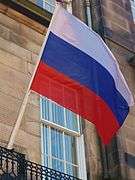 The tricolor at Russian Consulate-General in Edinburgh
The tricolor at Russian Consulate-General in Edinburgh The tricolor and the Banner of Victory on the 2009 Moscow Victory Day Parade
The tricolor and the Banner of Victory on the 2009 Moscow Victory Day Parade- Football fans with a gigantic Go Russia! banner, featuring the Russian Bear on the foreground of the tricolor

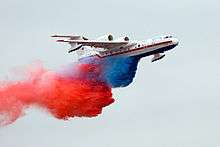 Beriev Be-200 dropping water painted into the national colors at the 2009 MAKS Airshow
Beriev Be-200 dropping water painted into the national colors at the 2009 MAKS Airshow The flag in the sky over the Moscow Kremlin on the 2010 Moscow Victory Day Parade
The flag in the sky over the Moscow Kremlin on the 2010 Moscow Victory Day Parade Flag over coffin of Anton Denikin in New York City, this was used as the Russian flag by White émigrés abroad during the Soviet period.
Flag over coffin of Anton Denikin in New York City, this was used as the Russian flag by White émigrés abroad during the Soviet period. Russian naval flag of the 74-gun ship Vladislav captured at the battle of Hogland in 1788
Russian naval flag of the 74-gun ship Vladislav captured at the battle of Hogland in 1788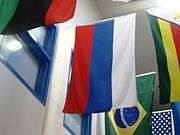 Tricolor flag hanging in a ceiling of a local high school in Toronto.
Tricolor flag hanging in a ceiling of a local high school in Toronto. Russian flag in Piterhoff
Russian flag in Piterhoff
Similar flags
|
See also
- Coat of arms of Russia
- Flags of the federal subjects of Russia
- Russian Navy Ensign
- Flag of the Russian SFSR
- Flag of the Soviet Union
- Coat of arms of Moscow
- List of Russian flags
- Pan-Slavic colors
References
- ↑ УКАЗ ПРЕЗИДЕНТА РОССИЙСКОЙ ФЕДЕРАЦИИ от 21 июля 1992 г. № 798 «О военно-морских флагах и вымпелах Российской Федерации»
- ↑ Оленин, Ростислав; Карманов, Владимир (2006). От первого корабля до первого устава. История морских флагов России (1669—1725 гг.) [From the first ship to first regulations. The history of Russian ensigns (1669—1725)]. С-Пб.: "Шатон". p. 146. ISBN 5-94988-018-8.
- ↑ Whitney Smith (2008). "Flag of Union of Soviet Socialist Republics". Encyclopædia Britannica. Retrieved 2008-11-05.
- ↑ Hulme, Frederick Edward (1897-01-01). The Flags of the World: Their History, Blazonry and Associations. Library of Alexandria. ISBN 9781465543110.
- ↑ Greenway, H. D. S. (2014-08-19). Foreign Correspondent: A Memoir. Simon and Schuster. p. 228. ISBN 9781476761329.
- ↑ Flag T.H. Eriksen & R. Jenkins, Nation and Symbolism in Europe and America. Abingdon, 2007, p. 23
- ↑ Robert K. Massie, Peter the Great, 160 (Modern Library Edition 2012)
- ↑ Russian flags at Flags of the World
- ↑ Lilia Shevtsova: Putin's Russia. Carnegie Endowment, 2010. p. 114
- ↑ Kathleen E. Smith: Mythmaking in the New Russia: Politics and Memory During the Yeltsin Era. Cornell University Press, 2002. p. 160
- ↑ Pantone 286 C
- ↑ Pantone 485 C
- ↑ Whitney Smith, Flags Through the Ages and Across the World, 1975. "The black-orange-white flag was very unpopular, so much so that the government felt compelled on 7 May 1883 to recognize the white-blue-red as official for use on land during celebrations. Hence the flag intended for unrestricted use was rarely seen in prerevolutionary Russia, while the flag restricted to special occasions was in fact the most likely to be hoisted whenever private citizens wished to express their nationality by displaying a flag on land."
- ↑ Resolution of the Supreme Soviet of the Russian SFSR from 22 August 1991 "On the national flag of the Russian SFSR"
- ↑ Law "On Amendments and Additions to the Constitution (Basic Law) of the Russian SFSR" from 1 November 1991
External links
| Wikimedia Commons has media related to Flags of Russia. |
- Official image of the Russian flag, on the official site of the Russian President.
- Text of the constitutional law about the flag. (initial variant, without amendments)
- Timeline Russian National Flag.(Italian)
- Flag of Russia - old link(Russian)
- Flag of Russia - Vexillographia(Russian)
- Flag of Russia(Russian)
- National Flag and Naval Ensign in Russia Navy.(Russian)

.svg.png)

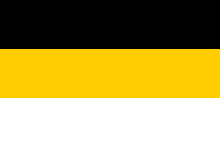
.svg.png)
.svg.png)
.svg.png)
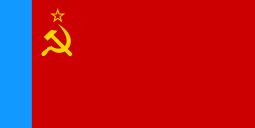
.svg.png)
.svg.png)
.svg.png)
.svg.png)
.svg.png)
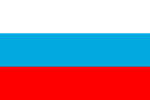
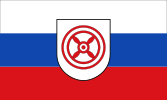





.jpg)